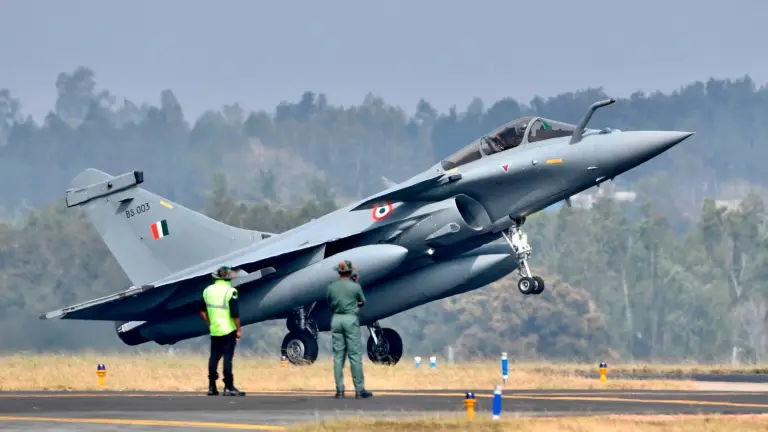DM Monitoring
PARIS: France’s steadfast refusal to provide India with access to the Rafale fighter jet’s source code has reignited strategic tensions, exposing the limitations of high-end arms procurement when digital sovereignty is off the table. Despite persistent diplomatic overtures by New Delhi, Dassault Aviation remains unwilling to hand over the critical software backbone that governs the Rafale’s mission sys-tems, weapons integration, and avionics suite.
India’s goal is to embed indigenous weapons like the Astra beyond-visual-range air-to-air missile, Ru-dram anti-radiation missile, and a host of smart munitions into the Rafale ecosystem to enhance com-bat autonomy and reduce reliance on foreign suppliers.
The move is a cornerstone of India’s “Atmanirbhar Bharat” (Self-Reliant India) initiative, which envi-sions a future where domestic R&D and manufacturing underpin the nation’s airpower capabilities. The Rafale, a twin-engine 4.5-generation multirole fighter, is powered by two Snecma M88-2 after-burning turbofan engines and is capable of supercruise at Mach 1.4 without afterburner, offering a high thrust-to-weight ratio and extended range.
Equipped with the Thales RBE2-AA Active Electronically Scanned Array (AESA) radar, the Rafale can track up to 40 targets and engage 8 simultaneously at ranges exceeding 100 km, making it one of the most advanced radar systems in its class.
The aircraft also features the Spectra electronic warfare suite, which includes radar warning receivers, jammers, and infrared missile warning sensors capable of detecting and defeating modern threats through active and passive countermeasures. India’s Rafale fleet is further equipped with Helmet Mounted Display Systems (HMDS), Thales Front Sector Optronics (FSO), IRST (Infrared Search and Track), and advanced data links for real-time network-centric operations.
The Rafale’s combat punch includes integration with the Meteor BVR missile with a no-escape zone of over 60 km, the SCALP-EG long-range cruise missile capable of precision strikes up to 500 km, and the Hammer (AASM) modular air-to-ground precision munitions. India acquired 36 Rafale jets in a €7.8 bil-lion (RM37.5 billion) contract signed in September 2016, with the first jet delivered on 29 July 2020 and the final aircraft arriving on 15 December 2022.
The Rafales are now operational at Ambala Airbase near Pakistan and Hasimara Airbase near the Chi-nese frontier, both chosen for their strategic relevance in India’s two-front war doctrine. To further enhance maritime strike capability, India inked a US$7.4 billion (RM33.3 billion) agreement in April 2025 for 26 Rafale-M fighters, the naval variant, to be deployed aboard INS Vikrant and INS Vikramaditya.
These carrier-borne jets will replace the ageing MiG-29K fleet and provide India with true fourth-plus-generation maritime airpower at sea—crucial amid China’s expanding carrier presence in the Indian Ocean.
Despite cooperation on integrating certain Indian-developed munitions like Astra Mk1 and the Smart Anti-Airfield Weapon (SAAW), France’s unwillingness to share Rafale’s core source code remains a crit-ical stumbling block in deeper defence cooperation. The source code in question governs mission-critical components, including the Modular Mission Computer (MMC) and the radar-electronic inter-face required for seamless weapons integration.
Without access to this digital architecture, India faces a capability bottleneck, unable to independently adapt the Rafale to evolving operational scenarios or to implement software-defined upgrades with-out French approval. “The absence of source code access represents a significant obstacle to India’s broader defence modernization agenda,” said a senior Indian Air Force official familiar with the matter.
The dispute has triggered a deeper national conversation about technological sovereignty, raising un-comfortable parallels with past experiences involving the Mirage 2000 fleet, where lack of code access hindered local upgrades. “While France has offered limited collaboration through joint technical teams and restricted software kits, India’s demand for full access reflects its desire to reduce reliance on for-eign suppliers and enhance its defense capabilities independently.”
Military planners argue that code access would allow India to quickly update mission parameters, inte-grate homegrown artificial intelligence-driven subsystems, and streamline logistics without external dependency.
France, however, argues that the source code—developed over decades at great financial cost—is a strategic industrial asset not open to foreign manipulation. The French defence establishment fears that granting access could set a dangerous precedent with other Rafale operators like Egypt, Qatar, and potentially Indonesia demanding similar concessions.
There are also real concerns that source code access could lead to security vulnerabilities, including the risk of reverse engineering, cyber intrusions, or unauthorized export of French technologies to rival states.
Moreover, France contends that unauthorized modifications by third parties could compromise aircraft integrity, safety certifications, and post-sale support agreements, endangering the entire Rafale ex-port program. Although limited workaround solutions exist—such as integration of Indian weapons via external pods or fire-and-forget mode—these are suboptimal and restrict the full exploitation of Ra-fale’s sensor-fusion and network-centric warfare potential.
Despite the standoff, India-France defence ties remain robust and expanding, underscored by the April 2025 Rafale-M deal which signals continued mutual trust in high-end technology sharing, even if not absolute. Indian officials believe the long-term answer lies in developing domestic 5th-generation fighters such as the AMCA and enhancing the Tejas Mk2 program—aircraft designed with full sover-eign control over mission systems.
Still, as global warfare evolves into a software-defined battlespace, the Rafale source code dispute is a stark reminder that even the most advanced jets are only as sovereign as the code they fly on. While France remains adamant in protecting the Rafale’s digital core, there are notable precedents where aircraft manufacturers have granted full or partial access to source codes or mission-critical software, especially to trusted strategic partners. The United States, for instance, granted Israel unprecedented access to the F-35’s software architecture, allowing the Israeli Air Force (IAF) to install its own com-mand, control, communications, and electronic warfare systems onto the “Adir” variant of the stealth fighter.
This autonomy enables Israel to operate the F-35 as a sovereign weapons platform, complete with in-tegration of locally developed air-to-ground munitions and proprietary cyber and EW suites, while maintaining its qualitative military edge in the region. Similarly, Russia has, in select cases, offered ex-tensive technical documentation and system access to close partners like India under the Su-30MKI program.
India was allowed to customize the Su-30MKI with indigenous systems such as the DRDO-developed radar warning receivers, Astra missiles, and locally sourced mission computers, all made possible through a level of openness that France has so far denied with the Rafale.
South Korea, through its partnership with Lockheed Martin on the KF-21 Boramae project, received significant technical transfer, including design blueprints, software integration support, and develop-mental collaboration—though not the full F-35 source code, which remains tightly controlled. Even Sweden’s Saab, in its bid for international Gripen sales, has offered full technology transfer and source code access to countries like Brazil, which now manufactures and modifies the Gripen-E domestically through a joint development and production model.
These examples show that with the right strategic alignment and trust frameworks, access to fighter aircraft source code—while sensitive—is not unprecedented. India’s defence establishment now finds itself questioning why such access is permitted for some allies but not extended to the world’s largest democracy and a key strategic partner of the West in the Indo-Pacific.
This double standard has only added fuel to the ongoing debate in India about real technological sov-ereignty in high-end defence procurement.




